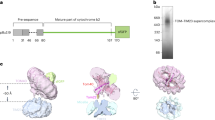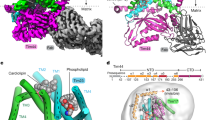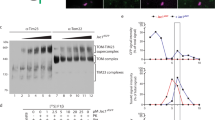Abstract
Preproteins synthesized on cytosolic ribosomes, but destined for the mitochondrial matrix, pass through the presequence translocase of the inner membrane. Translocation is driven by the import motor, having at its core the essential chaperone mtHsp70 (Ssc1 in yeast). MtHsp70 is tethered to the translocon channel at the matrix side of the inner membrane by the peripheral membrane protein Tim44. A key question in mitochondrial import is how the mtHsp70-Tim44 interaction is regulated. Here we report that Tim44 interacts with both the ATPase and peptide-binding domains of mtHsp70. Disruption of these interactions upon binding of polypeptide substrates requires concerted conformational changes involving both domains of mtHsp70. Our results fit a model in which regulated interactions between Tim44 and mtHsp70, controlled by polypeptide binding, are required for efficient translocation across the mitochondrial inner membrane in vivo.
This is a preview of subscription content, access via your institution
Access options
Subscribe to this journal
Receive 12 print issues and online access
$189.00 per year
only $15.75 per issue
Buy this article
- Purchase on Springer Link
- Instant access to full article PDF
Prices may be subject to local taxes which are calculated during checkout






Similar content being viewed by others
References
Neupert, W. & Brunner, M. The protein import motor of mitochondria. Nat. Rev. Mol. Cell Biol. 8, 555–565 (2002).
Wiedemann, N., Frazier, A.E. & Pfanner, N. The protein import machinery of mitochondria. J. Biol. Chem. 279, 14473–14476 (2004).
Jensen, R.E. & Johnson, A.E. Opening the door to mitochondrial protein import. Nat. Struct. Biol. 8, 1008–1010 (2001).
Bauer, M.F., Sirrenberg, C., Neupert, W. & Brunner, M. Role of Tim23 as voltage sensor and presequence receptor in protein import into mitochondria. Cell 87, 33–41 (1996).
Truscott, K. et al. A presequence- and voltage-sensitive channel of the mitochondrial preprotein translocase formed by Tim23. Nat. Struct. Biol. 8, 1074–1082 (2001).
Huang, S., Ratliff, K.S. & Matouschek, A. Protein unfolding by the mitochondrial membrane potential. Nat. Struct. Biol. 9, 301–307 (2002).
Kang, P.J. et al. Requirement for hsp70 in the mitochondrial matrix for translocation and folding of precursor proteins. Nature 348, 137–143 (1990).
Scherer, P., Krieg, U., Hwang, S., Vestweber, D. & Schatz, G. A precursor protein partially translocated into yeast mitochondria is bound to a 70kd mitochondrial stress protein. EMBO J. 9, 4315–4322 (1990).
Gambill, B.D. et al. A dual role for mitochondrial heat shock protein 70 in membrane translocation of preproteins. J. Cell Biol. 123, 109–117 (1993).
Pilon, M. & Schekman, R. Protein translocation: how Hsp70 pulls it off. Cell 97, 679–682 (1999).
Schneider, H.-C. et al. Mitochondrial Hsp70/MIM44 complex facilitates protein import. Nature 371, 768–774 (1994).
Voisine, C. et al. The protein import motor of mitochondria: unfolding and trapping of preproteins are distinct and separable functions of matrix Hsp70. Cell 97, 565–574 (1999).
Liu, Q., D'Silva, P., Walter, W., Marszalek, J. & Craig, E.A. Regulated cycling of mitochondrial Hsp70 at the protein import channel. Science 300, 139–141 (2003).
Maarse, A.C., Blom, J., Grivell, L.A. & Meijer, M. MPI, an essential gene encoding a mitochondrial membrane protein, is possibly involved in protein import into yeast mitochondria. EMBO J. 11, 3619–3628 (1992).
Scherer, P.E., Manning-Krieg, U.C., Jeno, P., Schatz, G. & Horst, M. Identification of a 45-kDa protein at the import site of the yeast mitochondrial inner membrane. Proc. Natl. Acad. Sci. USA 89, 11930–11934 (1992).
Mokranjac, D., Sichting, M., Neupert, W. & Hell, K. Tim14, a novel key component of the import motor of the Tim23 protein translocase of mitochondria. EMBO J. 22, 4945–4956 (2003).
Truscott, K.N. et al. A J-protein is an essential subunit of the presequence translocase-associated protein import motor of mitochondria. J. Cell Biol. 163, 707–713 (2003).
D'Silva, P.D., Schilke, B., Walter, W., Andrew, A. & Craig, E.A. J protein cochaperone of the mitochondrial inner membrane required for protein import into the mitochondrial matrix. Proc. Natl. Acad. Sci USA 100, 13839–13844 (2003).
Kozany, C., Mokranjac, D., Sichting, M., Neupert, W. & Hell, K. The J domain-related cochaperone Tim16 is a constituent of the mitochondrial TIM23 preprotein translocase. Nat. Struct. Mol. Biol. 11, 234–241 (2004).
Frazier, A.E. et al. Pam16 has an essential role in the mitochondrial protein import motor. Nat. Struct. Mol. Biol. 11, 226–233 (2004).
Liu, Q., Krzewska, J., Liberek, K. & Craig, E.A. Mitochondrial Hsp70 Ssc1:role in protein folding. J. Biol. Chem. 276, 6112–6118 (2001).
Bukau, B. & Horwich, A.L. The Hsp70 and Hsp60 chaperone machines. Cell 92, 351–366 (1998).
Hartl, F. & Hayer-Hartl, M. Molecular chaperones in the cytosol: from nascent chain to folded protein. Science 295, 1852–1858 (2002).
Rudiger, S., Buchberger, A. & Bukau, B. Interaction of Hsp70 chaperones with substrates. Nat. Struct. Biol. 4, 342–349 (1997).
Mayer, M.P. et al. Multistep mechanism of substrate binding determines chaperone activity of Hsp70. Nat. Struct. Biol. 7, 586–593 (2000).
Buchberger, A., Reinstein, J. & Bukau, B. The DnaK chaperone system: mechanism and comparison with other Hsp70 systems. In Molecular Chaperones and Folding Catalysts: Regulation, Cellular Function and Mechanisms (ed. Bukau, B.) 609–635 (Harwood Academic, 1999).
Laufen, T. et al. Mechanism of regulation of Hsp70 chaperones by DnaJ co-chaperones. Proc. Natl. Acad. Sci. USA 96, 5452–5457 (1999).
Krimmer, T., Rassow, J., Kunau, W.H., Voos, W. & Pfanner, N. Mitochondrial protein import motor: the ATPase domain of matrix Hsp70 is crucial for binding to Tim44, while the peptide binding domain and the carboxy-terminal segment play a stimulatory role. Mol. Cell. Biol. 20, 5879–5887 (2000).
Moro, F., Okamoto, K., Donzeau, M., Neupert, W. & Brunner, M. Mitochondrial protein import: molecular basis of the ATP-dependent interaction of MtHsp70 with Tim44. J. Biol. Chem. 277, 6874–6880 (2002).
Strub, A., Rottgers, K. & Voos, W. The Hsp70 peptide-binding domain determines the interaction of the ATPase domain with Tim44 in mitochondria. EMBO J. 21, 2626–2635 (2002).
Craig, E.A. & Marszalek, J. A specialized mitochondrial molecular chaperone system: a role in formation of Fe/S centers. Cell Mol. Life Sci. 59, 1658–1665 (2002).
Zhu, X. et al. Structural analysis of substrate binding by the molecular chaperone DnaK. Science 272, 1606–1614 (1996).
Voos, W. et al. Differential requirement for the mitochondrial Hsp70–Tim44 complex in unfolding and translocation of preproteins. EMBO J. 15, 2668–2677 (1996).
Merlin, A. et al. The J-related segment of Tim44 is essential for cell Viability: A mutant Tim44 remains in the mitochondrial import site, but inefficiently recruits mtHSP70 and impairs protein translocation. J. Cell Biol. 145, 961–972 (1999).
Lim, J.H., Martin, F., Guiard, B., Pfanner, N. & Voos, W. The mitochondrial Hsp70-dependent import system actively unfolds preproteins and shortens the lag phase of translocation. EMBO J. 20, 941–950 (2001).
Geissler, A., Rassow, J., Pfanner, N. & Voos, W. Mitochondrial import driving forces: enhanced trapping by matrix Hsp70 stimulates the translocation and reduces the membrane potential dependence of loosely folded preproteins. Mol. Cell. Biol. 21, 7097–7104 (2001).
Rassow, J. et al. Mitochondrial protein import: biochemical and genetic evidence for interaction of matrix Hsp70 and the inner membrane protein Mim44. J. Cell Biol. 127, 1547–1556 (1994).
Strub, A., Zufall, N. & Voos, W. The putative helical lid of the Hsp70 peptide-binding domain is required for efficient preprotein translocation into mitochondria. J. Mol. Biol. 334, 1087–1099 (2003).
Jordan, R. & McMacken, R. Modulation of the ATPase activity of the molecular chaperone DnaK by peptides and the DnaJ and GrpE heat shock proteins. J. Biol. Chem. 270, 4563–4569 (1995).
O'Brien, M. & McKay, D. Threonine 204 of the chaperone protein hsc70 influences the structure of the active site but is not essential for ATP hydrolysis. J. Biol. Chem. 268, 24323–24329 (1993).
Lopez-Buesca, P., Pfund, C. & Craig, E.A. The biochemical properties of the ATPase activity of a 70-kDa heat shock protein (Hsp70) are governed by the C-terminal domains. Proc. Natl. Acad. Sci. USA 95, 15253–15258 (1998).
Slepenkov, S.V. & Witt, S.N. Peptide-induced conformational changes in the molecular chaperone DnaK. Biochemistry 37, 16749–16756 (1998).
Slepenkov, S. & Witt, S. Detection of a concerted conformational change in the ATPase domain of DnaK triggered by peptide binding. FEBS Lett. 539, 100–104 (2003).
Miao, B., Davis, J.E. & Craig, E.A. Mge1 functions as a nucleotide release factor for Ssc1, a mitochondrial Hsp70 of Saccharomyces cerevisiae. J. Mol. Biol. 265, 541–552 (1997).
Miroux, B. & Walker, J.E. Over-production of proteins in Escherichia coli: Mutant hosts that allow synthesis of some membrane proteins and Globular proteins at high levels. J. Mol. Biol. 260, 289–298 (1996).
Horst, M. et al. Sequential action of two hsp70 complexes during protein import into mitochondria. EMBO J. 16, 1842–1849 (1997).
Dutkiewicz, R. et al. Ssq1, a mitochondrial Hsp70 involved in iron-sulfur (Fe/S) center biogenesis: Similarities to and differences from its bacterial counterparts. J. Biol. Chem. 278, 29719–29727 (2003).
Acknowledgements
We thank J. Marszalek for helpful comments on the manuscript. This work was supported by National Institutes of Health Grant GM278709 (to E.A.C.) and American Heart Association Fellowship 0420049Z (P.D.).
Author information
Authors and Affiliations
Corresponding author
Ethics declarations
Competing interests
The authors declare no competing financial interests.
Supplementary information
Supplementary Fig. 1
Effect of CoxIV peptide on Ssc1-Tim44 interactions in vitro. (PDF 111 kb)
Rights and permissions
About this article
Cite this article
D'Silva, P., Liu, Q., Walter, W. et al. Regulated interactions of mtHsp70 with Tim44 at the translocon in the mitochondrial inner membrane. Nat Struct Mol Biol 11, 1084–1091 (2004). https://doi.org/10.1038/nsmb846
Received:
Accepted:
Published:
Issue Date:
DOI: https://doi.org/10.1038/nsmb846
This article is cited by
-
HSPA9/Mortalin mediates axo-protection and modulates mitochondrial dynamics in neurons
Scientific Reports (2021)
-
Hsp70 at the membrane: driving protein translocation
BMC Biology (2018)
-
Granzyme B enters the mitochondria in a Sam50-, Tim22- and mtHsp70-dependent manner to induce apoptosis
Cell Death & Differentiation (2017)
-
Integrin-FAK signaling rapidly and potently promotes mitochondrial function through STAT3
Cell Communication and Signaling (2016)
-
J domain independent functions of J proteins
Cell Stress and Chaperones (2016)



